
Plethodon is a genus of salamanders in the family Plethodontidae. They are also known as woodland salamanders or, more rarely, slimy salamanders. All members of the genus are endemic to North America. They have no aquatic larval stage. In some species, such as Plethodon cinereus, the red-backed salamander, eggs are laid underneath a stone or log. Young hatch in the adult form. Members of Plethodon primarily eat small invertebrates. The earliest known fossils of this genus are from the Hemphillian of Tennessee in the United States.
The Siskiyou Mountains salamander, also called the Siskiyou Mountain salamander, exists only in isolated locations along the Klamath River in northern California and southern Oregon. It is a close relative of the Del Norte salamander, and some herpetologists believe it may be a subspecies of that animal.

The northern slimy salamander is a species of terrestrial plethodontid salamander found throughout much of the eastern two-thirds of the United States.
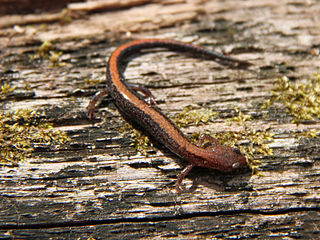
The southern red-backed salamander is a species of salamander endemic to the United States. It is found in four widely disjunct populations: one in central Louisiana; one in the Ouachita Mountains of Arkansas and Oklahoma; one in central Missouri; and one from southeastern Tennessee, to southwestern North Carolina, western Georgia, and eastern Alabama. It is sometimes referred to as the Georgia red-backed salamander or the Ouachita red-backed salamander. It was once considered a subspecies of the red-backed salamander, Plethodon cinereus.

Van Dyke's salamander is a small woodland salamander in the family Plethodontidae, the lungless salamanders. These animals breathe through their skin and are largely terrestrial. Compared to other salamanders in Plethodon it is relatively stocky with long legs. Usually associated with streams, seepages, and rock outcrops, it is endemic to Washington where it is found in a limited number of small, isolated populations.
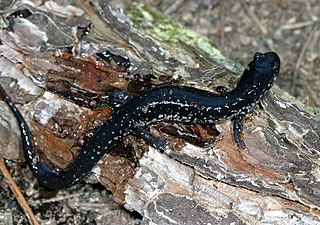
The white-spotted slimy salamander is a species of salamander in the family Plethodontidae endemic to the Eastern United States. It is one of 55 species in the genus Plethodon, and was one of the first to be described of its cogeners.

Dunn's salamander is a species of salamander in the family Plethodontidae endemic to the western United States.
The northern ravine salamander is a species of salamander in the family Plethodontidae. The species is endemic to the United States.
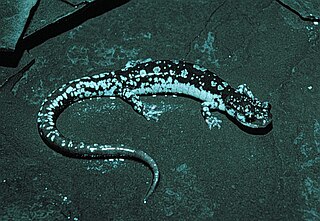
The Fourche Mountain salamander is a species of salamander in the family Plethodontidae endemic to the Ouachita Mountains in the central United States. Its natural habitat is temperate forests and it is threatened by habitat loss.
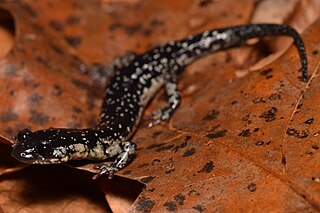
The Cumberland Plateau salamander is a species of salamander in the family Plethodontidae. It is endemic to the Cumberland Plateau, the southeastern United States. Its natural habitat is temperate forests. It is threatened by habitat loss.
The Kiamichi slimy salamander is a species of salamander in the family Plethodontidae endemic to the United States, has a natural habitat of temperate forests, and is found over a small range. This nocturnal species is mainly threatened by habitat loss and was first described by Highton in 1989. It is rated as a vulnerable species by the International Union for Conservation of Nature.
The Louisiana slimy salamander is a species of salamander in the family Plethodontidae. It is endemic to the United States where it is only known from northern Louisiana and southern Arkansas. Its natural habitat is hardwood forests. Little is known about this species, but it appears to be common within its range with some populations likely impacted by deforestation.
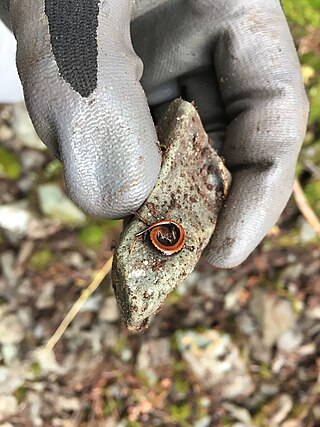
The Larch Mountain salamander is a species of salamander in the family Plethodontidae endemic to the United States. It occurs in the Cascade Mountains of southern Washington and northern Oregon. In Washington, it occurs from the Columbia River Gorge to just north of Snoqualmie Pass. Its natural habitats are temperate forests and rocky areas. It is threatened by habitat loss.

The Cow Knob salamander, also known as the white-spotted salamander, is a species of salamander in the family Plethodontidae. It is endemic to the United States. It is found on Shenandoah Mountain, Nathaniel Mountain and Great North Mountain in eastern West Virginia and western Virginia. Most of its known locations are in the George Washington National Forest.
The Sequoyah slimy salamander is a species of salamander in the family Plethodontidae.

The Webster's salamander is a species of salamander in the family Plethodontidae. It is endemic to the southeast United States, in patchy and disjunct lowland subpopulations ranging from South Carolina to Louisiana. Its natural habitat is mixed mesophytic temperate forests, in association with rocky streams and outcrops.
The Mississippi slimy salamander is a species of terrestrial plethodontid salamander found throughout most of the U.S. state of Mississippi, western Alabama, western Tennessee, far western Kentucky, and eastern Louisiana. The Mississippi slimy salamander is part of the larger slimy salamander complex.
The Ocmulgee slimy salamander is a species of salamander in the family Plethodontidae. It is endemic to the state of Georgia in the United States, where it is found in regions of the coastal plain and Piedmont that are associated with the Ocmulgee River drainage system. It is only known from a few counties, and due to this restricted range, it is at high risk of extinction. Many populations of this species are already experiencing precipitous declines, with some even possibly being extirpated.












